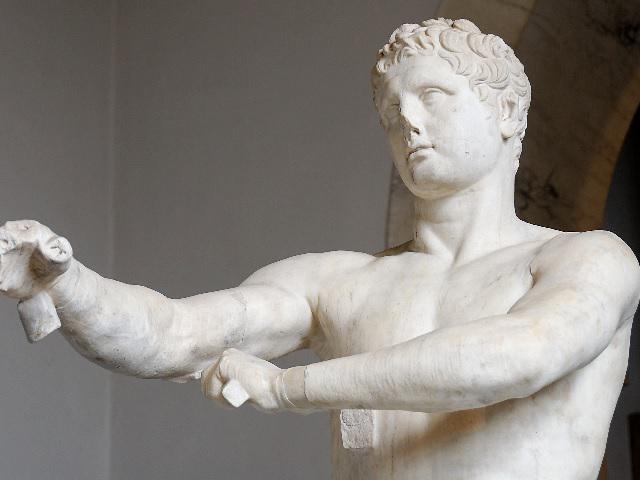Apoxyomenos

The Apoxyomenos, also known as the "Scraper," is a renowned ancient Greek sculpture that depicts a young athlete in the act of cleaning his body with a strigil. This particular statue, the Apoxyomenos of Lysippus, is considered the only complete specimen of its kind. Dating back to the 4th century BC, it is believed to be a copy of a lost bronze statue created by the famous sculptor Lysippus. The discovery of this masterpiece in 1849 in the Roman neighborhood of Trastevere was a significant moment in the world of art history.
Standing at an impressive height of 2.05 meters, the Apoxyomenos showcases the skill and artistry of ancient Greek sculptors. Despite undergoing various restorations over the years, the statue still retains its grandeur and beauty. One of the most striking features of the sculpture is its use of contraposto, a technique that creates a sense of movement and dynamism. As you observe the statue from different angles, you will notice how the athlete's pose conveys a sense of grace and athleticism.
The Apoxyomenos is a work of art that invites contemplation and admiration. Its intricate details and lifelike representation of the human form make it a masterpiece of classical sculpture. The statue's historical significance, as a rare example of a complete Apoxyomenos, adds to its allure and makes it a must-see for art enthusiasts and history buffs alike.
As you stand before the Apoxyomenos, take a moment to appreciate the craftsmanship and skill that went into creating this iconic sculpture. From the delicate curves of the athlete's body to the subtle expression on his face, every detail is meticulously crafted to capture the essence of ancient Greek art. Whether you are a seasoned art connoisseur or a casual observer, the Apoxyomenos is sure to leave a lasting impression on you.
In conclusion, the Apoxyomenos is not just a statue but a testament to the artistic genius of the ancient Greeks. Its timeless beauty and historical significance make it a valuable cultural treasure that deserves to be celebrated and preserved for future generations to admire. So, take the time to visit this extraordinary work of art and immerse yourself in the rich history and artistry of the ancient world.
© ChatGPT 3.5
*Although it has practically been assumed that this statue is a copy of the lost ancient Greek bronze work made by Lysippus, some authors have questioned whether this work is similar to the statue made by Lysippus.
*The sculpture was found by some workers in the ruins of what were then believed to be the Roman baths.
*The statue has enjoyed great popularity since it was discovered.
*It was restored by the Italian sculptor Pietro Tenerani, who completed the missing fingers on the right hand, reconstructed the missing strigile on the left hand, and hid the athlete's genitals behind a fig leaf; however, those repairs have been removed.
*The head is treated like a portrait, with messy hair, a marked forehead and sunken eyes.
*These characteristics are seen by some experts as details that give vividness to the character's head, although on the other hand, there are experts who consider them as defects attributable to whoever copied the work or to an error in presenting the height: it could have been settled on a banked base.